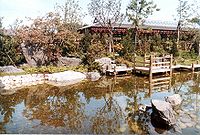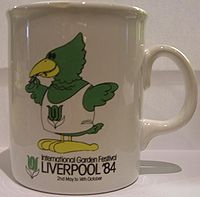
International Garden Festival
Encyclopedia


National Garden Festival
The National Garden Festivals were part of the cultural regeneration of large areas of derelict land in Britain's industrial districts during the 1980s and early 1990s. Five were held in total - one every two years, each in a different town or city - after the idea was pushed by environment...
recognised by the International Association of Horticultural producers
AIPH
The International Association of Horticultural Producers is an international organisation dedicated to promoting horticultural producers and held the international garden / flora festivals or expositions worldwide.-History:...
(AIPH) and the Bureau of International Exhibitions
Bureau of International Expositions
The International Exhibitions Bureau is an intergovernmental organization created to supervise international exhibitions falling under the jurisdiction of the Convention Relating to International Exhibitions....
and held in Liverpool
Liverpool
Liverpool is a city and metropolitan borough of Merseyside, England, along the eastern side of the Mersey Estuary. It was founded as a borough in 1207 and was granted city status in 1880...
, England
England
England is a country that is part of the United Kingdom. It shares land borders with Scotland to the north and Wales to the west; the Irish Sea is to the north west, the Celtic Sea to the south west, with the North Sea to the east and the English Channel to the south separating it from continental...
from 2 May 1984 to 14 October 1984. It was the first such event held in Britain, and became the model for several others held during the 1980s and early 1990s. The aim was to revitalise tourism
Tourism
Tourism is travel for recreational, leisure or business purposes. The World Tourism Organization defines tourists as people "traveling to and staying in places outside their usual environment for not more than one consecutive year for leisure, business and other purposes".Tourism has become a...
and the city of Liverpool which had been in decline, and the idea came from Conservative Environment Minister Michael Heseltine
Michael Heseltine
Michael Ray Dibdin Heseltine, Baron Heseltine, CH, PC is a British businessman, Conservative politician and patron of the Tory Reform Group. He was a Member of Parliament from 1966 to 2001 and was a prominent figure in the governments of Margaret Thatcher and John Major...
.
The festival was hugely popular, attracting 3,380,000 visitors.
The festival
The garden festival was held on a 950,000 square metre derelict industrial site south of Herculaneum DockHerculaneum Dock
Herculaneum Dock was part of the Port of Liverpool in Liverpool, England. It was situated at the southern end of the Liverpool dock system, on the River Mersey. To the north it was connected to Harrington Dock. The dock was named after the Herculaneum Pottery Company that had occupied the site...
, near the Dingle
Dingle, Liverpool
Dingle is an inner-city area of Liverpool, Merseyside, England. It is located to the south of the city, bordered by the adjoining districts of Toxteth and Aigburth...
and overlooking the River Mersey
River Mersey
The River Mersey is a river in North West England. It is around long, stretching from Stockport, Greater Manchester, and ending at Liverpool Bay, Merseyside. For centuries, it formed part of the ancient county divide between Lancashire and Cheshire....
. On this site was built sixty individual gardens, including a Japanese garden and pagoda
Pagoda
A pagoda is the general term in the English language for a tiered tower with multiple eaves common in Nepal, India, China, Japan, Korea, Vietnam and other parts of Asia. Some pagodas are used as Taoist houses of worship. Most pagodas were built to have a religious function, most commonly Buddhist,...
s. A large glass dome, the Festival Hall, formed the centrepiece of the site and housed numerous indoor exhibits.
Other attractions included a walk of fame, featuring numerous stars connected with Liverpool, and a light railway system (see below). Public artwork included the Yellow Submarine
Yellow Submarine (Liverpool)
The Yellow Submarine in Liverpool is a large model representation of the submarine featured in the animated film Yellow Submarine, and in the song of that name on the Beatles album Revolver. It was built by a group of about 80 apprentices from Cammell Laird's shipyard, for exhibition at the...
, a statue of John Lennon
John Lennon
John Winston Lennon, MBE was an English musician and singer-songwriter who rose to worldwide fame as one of the founding members of The Beatles, one of the most commercially successful and critically acclaimed acts in the history of popular music...
, a Blue Peter
Blue Peter
Blue Peter is the world's longest-running children's television show, having first aired in 1958. It is shown on CBBC, both in its BBC One programming block and on the CBBC channel. During its history there have been many presenters, often consisting of two women and two men at a time...
ship, the Wish You Were Here tourist sculpture, a kissing gate and a red dragon slide and a large red bull sculpture.
The festival railway
A gauge minimum gauge railwayMinimum gauge railway
Minimum gauge railways have a gauge of less than or , most commonly , , or . The notion of minimum gauge railways was originally developed by estate railways and by the French company of Decauville for industrial railways....
system provided transport around the site. The light railway system consisted of a mainline providing transport links between a series of stations at key locations around the festival site, and a junction linking to a branch line. There were also extensive shed and workshop facilities. A considerable investment was made in the purchase of passenger coaches, and in the purchase and installation of permanent way
Permanent way
The permanent way is the elements of railway lines: generally the pairs of rails typically laid on the sleepers embedded in ballast, intended to carry the ordinary trains of a railway...
. Additional passenger coaches (of the 20-seat 'teak' saloon type) were borrowed from the Romney, Hythe and Dymchurch Railway in Kent
Kent
Kent is a county in southeast England, and is one of the home counties. It borders East Sussex, Surrey and Greater London and has a defined boundary with Essex in the middle of the Thames Estuary. The ceremonial county boundaries of Kent include the shire county of Kent and the unitary borough of...
. The prohibitive cost of purchasing locomotives was avoided through the use of engines which were deemed 'spare' on other existing gauge minimum gauge railways, particularly the United Kingdom's two most extensive railways of this gauge, the Romney, Hythe and Dymchurch Railway
Romney, Hythe and Dymchurch Railway
The Romney, Hythe & Dymchurch Railway is a gauge light railway in Kent, England. The line runs from the Cinque Port of Hythe via Dymchurch, St...
, and the Ravenglass and Eskdale Railway
Ravenglass and Eskdale Railway
The Ravenglass and Eskdale Railway is a minimum gauge heritage railway in Cumbria, England. The line runs from Ravenglass to Dalegarth Station near Boot in the valley of Eskdale, in the Lake District...
. The cost of building and hiring passenger coaches was partly offset through sponsorship by the National Westminster Bank
National Westminster Bank
National Westminster Bank Plc, commonly known as NatWest, is the largest retail and commercial bank in the United Kingdom and has been part of The Royal Bank of Scotland Group Plc since 2000. The Royal Bank of Scotland Group is ranked as the second largest bank in the world by assets...
, whose name and logo was painted on the side of every coach. The visiting locomotives, leased coaches, and purpose-built passenger carriages provided the mainline service, whilst the branch line was operated on a shuttle basis by a 1970s-built diesel multiple unit
Diesel multiple unit
A diesel multiple unit or DMU is a multiple unit train consisting of multiple carriages powered by one or more on-board diesel engines. They may also be referred to as a railcar or railmotor, depending on country.-Design:...
railcar set (named Silver Jubilee) on loan from the Ravenglass and Eskdale Railway.
The festival site
Since the festival closed, the site has passed through the hands of a series of developers. From the late 1980s until its closure in 1996, the Festival Hall was used as the Pleasure Island amusement park. Half of the site has since been turned into residential housing. The Festival Hall dome was demolished in late 2006.In November 2006 local companies Langtree and McLean announced plans for the site that will see more than 1,000 new homes built around the cleared dome area, as well as the restoration of the original gardens created for the festival in 1984.
In September 2009 it was announced that work would begin on redeveloping the site in November 2009, after the city council
Liverpool City Council
Liverpool City Council is the governing body for the city of Liverpool in Merseyside, England. It consists of 90 councillors, three for each of the city's 30 wards. The council is currently controlled by the Labour Party and is led by Joe Anderson.-Domain:...
gave permission for work to begin. The redevelopment will see the Chinese
Chinese garden
The Chinese garden, also known as a Chinese classical garden, is a style of landscape garden which has evolved for more than three thousand years, and which is inspired by Chinese literature, Chinese painting and Chinese philosophy...
and Japanese garden
Japanese garden
, that is, gardens in traditional Japanese style, can be found at private homes, in neighborhood or city parks, and at historical landmarks such as Buddhist temples, Shinto shrines and old castles....
s being restored, as well as the lakes and associated watercourses and the woodland sculpture trails. Funding will come from a range of sources, including the Northwest Regional Development Agency
Northwest Regional Development Agency
The Northwest Regional Development Agency is the regional development agency for the North West England region and is a non-departmental public body.....
, who are providing a £2.1million grant. The developers Langtree have also announced that they still intend to build the 1300 planned homes on the site "as soon as the market conditions allow", despite the collapse of partner David McLean Homes.
External links
- BBC Liverpool: 20 years since the festival showing the site in 1984 and 2004
- Campaign to restore the festival site
- Community website for the area
- Langtree Group's official page for the Festival Gardens site
53°22′21"N 2°57′21"W

